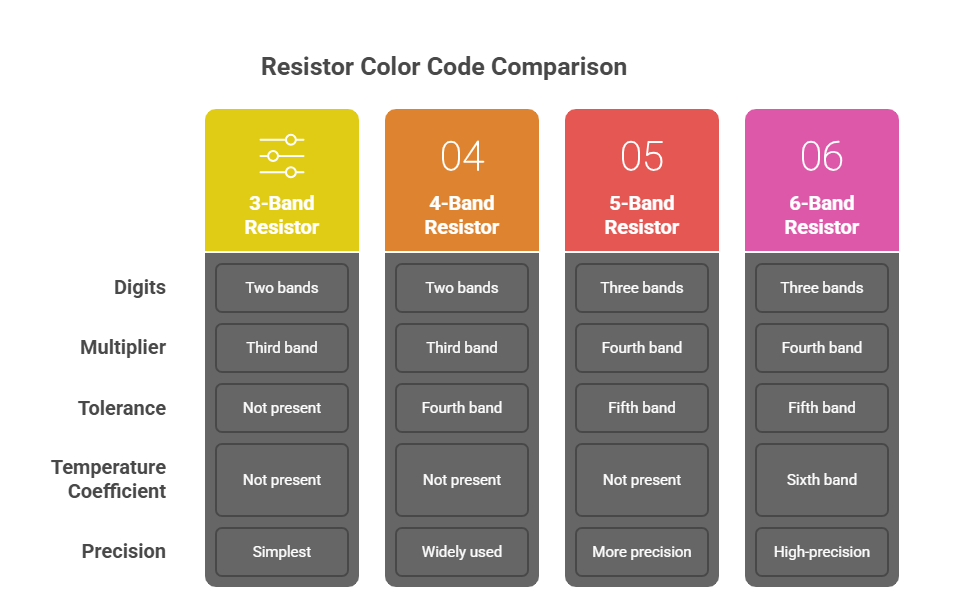Resistor Color Code Guide: 3-Band, 4-Band, 5-Band & 6-Band Explained

Understanding Resistor Color Codes: A Complete Guide for Engineers & OEMs
Resistors are one of the most common electronic components, and identifying their values correctly is essential in circuit design, testing, and repair. Since most resistors don’t have printed values, engineers rely on the resistor color code system to determine resistance. In this guide, we’ll cover 3-band, 4-band, 5-band, and 6-band resistor color codes, provide a resistor color code chart, and explain how to read values such as 1k, 10k, 100k, 220 ohm, 470 ohm, and more.
What is a Resistor Color Code?
A resistor color code is a system of colored bands printed on resistors that indicate their resistance value, tolerance, and sometimes reliability or temperature coefficient. Instead of writing the resistance, manufacturers use color bands for compactness and easy identification.
Resistor Color Code Chart
The chart below shows the values for each color. This applies to 3 band, 4 band, 5 band, and 6 band resistors:

How to Read Resistor Through Color Code

How to Read 3-Band Resistor Color Code
The 3-band resistor color code is the simplest. The first two bands represent significant digits, and the third band is the multiplier.
Example: Red (2), Violet (7), Orange (×1000) → 27kΩ.
How to Read 4-Band Resistor Color Code
The 4-band resistor color code is the most widely used. The first two bands are digits, the third is the multiplier, and the fourth shows tolerance.
Example: Brown (1), Black (0), Red (×100), Gold (±5%) → 1kΩ ±5%.
How to Read 5-Band Resistor Color Code
The 5-band resistor color code gives more precision. The first three bands are digits, the fourth is the multiplier, and the fifth is tolerance.
Example: Yellow (4), Violet (7), Black (0), Brown (×10), Brown (±1%) → 470Ω ±1%.
How to Read 6-Band Resistor Color Code
The 6-band resistor color code is similar to the 5-band but has an additional band for temperature coefficient, making it useful for high-precision circuits.
Example: Red (2), Green (5), Black (0), Red (×100), Brown (±1%), Blue (10 ppm/°C) → 2.5kΩ ±1%, 10 ppm/°C.
Resistor Color Code Calculator
Choose band colors — the resistor image updates live. Click Calculate for real resistance & tolerance.
–
Instead of memorizing values, you can use above resistor color code calculator to quickly find resistance. These tool support 3,4,5 and 6-band resistor color code calculator making identification faster and error-free.
Why This Matters for OEMs and Engineers

Understanding resistor color codes helps OEMs and engineers avoid mistakes in circuit design and assembly. Whether it’s a 1k ohm resistor color code or a 470k ohm resistor color code, accurate identification ensures reliability in industrial and consumer electronics.
Conclusion
Resistor color codes are essential for identifying resistance values in compact components. By learning how to read 3-band, 4-band, 5-band, and 6-band resistor codes and using tools like a resistor color code calculator, engineers and OEMs can ensure accurate, reliable circuit designs.
FAQs
1. How do you read a 3-band resistor?
First two bands = digits, third = multiplier.
2. What is the 4-band resistor color code?
Two digits, multiplier, and tolerance band.
3. What is a 5-band resistor?
Three digits, multiplier, and tolerance for higher accuracy.
4. What does the 6th band show?
It shows the temperature coefficient.
5. Is there a resistor color code calculator?
Yes, use the calculator above for 3, 4, 5, and 6-band resistors.



